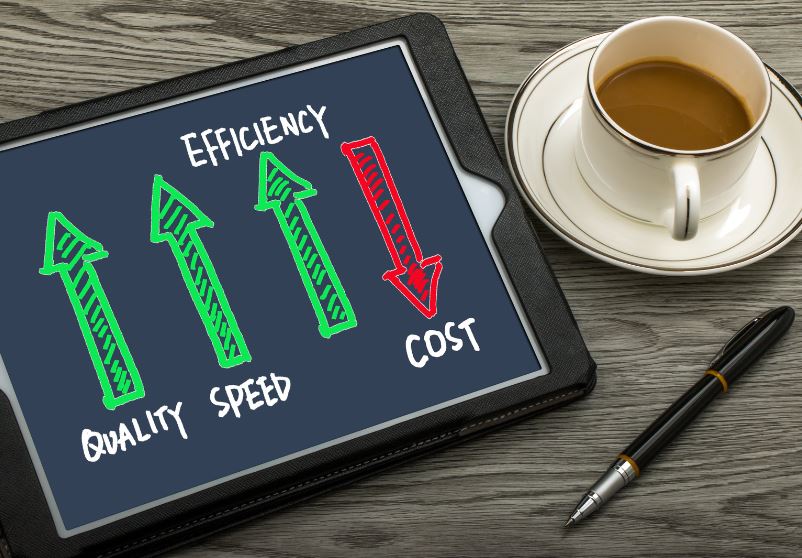Managing IT costs is a crucial aspect of running a successful business. In today's technology-driven world, businesses heavily rely on IT infrastructure and services to operate efficiently and stay competitive. However, these IT investments can sometimes become a significant financial burden. That's where IT cost reduction strategies come into play. Partnering with an IT Service Provider can help businesses identify and implement these strategies effectively.

Importance of Managing IT Costs
Effectively managing IT costs is essential for several reasons. Firstly, it allows businesses to allocate their resources more efficiently, ensuring that IT expenditures align with their overall budget and objectives. By optimizing IT costs, businesses can free up funds to invest in other areas that drive growth and innovation.
Managing IT costs also helps businesses maintain financial stability and improve profitability. By identifying and implementing cost reduction strategies, businesses can minimize unnecessary expenses and maximize the value they derive from their IT investments.
Overview of IT Cost Reduction Strategies
There are various strategies businesses can employ to reduce IT costs without compromising the quality and effectiveness of their IT operations. These strategies focus on optimizing infrastructure, strategic vendor management, embracing cloud solutions, enhancing IT security, and monitoring and optimization.
- Optimizing Infrastructure: Assessing the current IT infrastructure is the first step in identifying opportunities for cost reduction. This involves analyzing hardware, software, and network components to identify inefficiencies or areas for improvement. Consolidating and virtualizing resources can help eliminate redundancies, reduce maintenance costs, and improve overall IT performance.
- Strategic Vendor Management: Negotiating contracts and service level agreements (SLAs) can significantly impact IT costs. By negotiating favorable terms and conditions, businesses can secure better pricing, flexible contract terms, and improved service levels from their vendors. Vendor consolidation and streamlining can also lead to cost savings by reducing the number of vendors and leveraging economies of scale.
- Embracing Cloud Solutions: Transitioning to cloud-based services can provide businesses with significant cost savings. Cloud platforms offer scalability, flexibility, and pay-as-you-go pricing models. By leveraging cost-effective cloud platforms, businesses can reduce capital expenditures, eliminate the need for on-premises infrastructure, and optimize IT resource utilization.
- Enhancing IT Security: Investing in robust cybersecurity measures and implementing data protection protocols is essential for reducing IT costs associated with data breaches and security incidents. By preventing costly security breaches, businesses can avoid financial losses, reputation damage, and regulatory penalties. Investing in technologies like email filtering, multi-factor authentication, and strong password policies can definitely enhance IT security.
- Monitoring and Optimization: Continuous monitoring of IT systems and performance optimization are critical for identifying cost reduction opportunities. By regularly monitoring IT infrastructure, businesses can detect inefficiencies, identify areas of improvement, and make data-driven decisions to optimize their IT operations. This includes optimizing resource utilization, improving energy efficiency, and implementing cost efficiency strategies.
Implementing these IT cost reduction strategies allows businesses to achieve greater financial efficiency, improve their bottom line, and ensure that IT investments align with overall business goals. Assessing the unique needs and requirements of your business and tailoring these strategies accordingly maximizes cost-saving opportunities.

Optimizing Infrastructure
Optimizing the IT infrastructure is a fundamental step in reducing IT costs for businesses. By assessing the current infrastructure and implementing strategies to consolidate and virtualize resources, organizations can streamline operations and achieve significant cost savings.
Assessing Current Infrastructure
During the assessment process, it's crucial to consider factors such as outdated or underutilized equipment, legacy systems, and redundant software licenses. Legacy systems, in particular, can be a significant drain on resources due to their maintenance costs and limited compatibility with modern technologies.
Identifying areas where the infrastructure can be optimized allows businesses to make informed decisions about which cost reduction strategies to implement.
Consolidating and Virtualizing Resources
Consolidating and virtualizing resources is a highly effective strategy for optimizing IT infrastructure and reducing costs. This involves consolidating servers, storage systems, and networking equipment to eliminate redundancy and improve efficiency.
Reducing the number of physical servers through server consolidation allows businesses to save on hardware costs, power consumption, and maintenance expenses. Virtualization technology enables multiple operating systems and applications to run on a single physical server, maximizing resource utilization and improving scalability. This approach also facilitates easy migration of workloads between servers as needed.
Furthermore, data storage consolidation can be achieved by implementing centralized storage solutions, such as a storage area network (SAN) or network-attached storage (NAS). These solutions provide a more efficient and scalable storage infrastructure, reducing the need for multiple storage devices and simplifying data management.
Benefits of consolidation and virtualization include:
- Cost savings through reduced hardware requirements
- Lower power consumption and cooling costs
- Improved resource utilization and scalability
- Streamlined management and maintenance
- Enhanced disaster recovery capabilities
Through the consolidation and virtualization of resources, businesses can achieve cost savings while also improving the overall performance and flexibility of their IT infrastructure. It's important to partner with experienced IT professionals to ensure a smooth transition and ongoing management of the consolidated and virtualized environment.
Optimizing infrastructure through assessment, consolidation, and virtualization enables businesses to significantly reduce IT costs while maintaining a robust and efficient technology environment. This foundational approach supports the implementation of additional cost reduction strategies in other areas of IT management.
Strategic Vendor Management
Efficient vendor management is a critical aspect of IT cost reduction strategies. By effectively negotiating contracts and streamlining vendors, businesses can optimize their IT expenses. In this section, we will explore two key strategies for strategic vendor management: negotiating contracts and service level agreements, and vendor consolidation and streamlining.
Negotiating Contracts and Service Level Agreements
Working with vendors requires negotiating contracts and service level agreements (SLAs) that align with your business objectives and budget. By carefully reviewing and negotiating the terms, businesses can achieve cost savings and favorable conditions. Here are a few key considerations when negotiating contracts and SLAs.
- Pricing: Negotiate competitive pricing that reflects the value of the products or services. Seek discounts for long-term commitments or volume purchases.
- Flexibility: Ensure that the contract allows for flexibility to scale up or down based on your changing business needs. This can help avoid unnecessary costs if your requirements change.
- Performance Metrics: Define clear performance metrics and penalties for non-compliance. This encourages vendors to meet the agreed-upon service levels, ensuring quality and efficiency.
- Contract Duration: Consider the length of the contract and whether it aligns with your business strategy. Longer-term contracts may provide cost advantages, but ensure that you have the ability to renegotiate terms if necessary.
- Termination Clauses: Include termination clauses that protect your business in case of unsatisfactory performance or changes in your requirements.
Carefully negotiating contracts and SLAs allows businesses to establish mutually beneficial partnerships that provide cost savings and efficient service delivery. For more information on service level agreements, you can refer to our article on service level agreements.
Vendor Consolidation and Streamlining
Managing multiple vendors can be complex and costly. Vendor consolidation and streamlining is a strategy that involves reducing the number of vendors you work with while maintaining or improving service quality. This can lead to cost savings and increased efficiency. Consider the following steps when implementing vendor consolidation and streamlining:
- Vendor Assessment: Evaluate the performance, cost, and value of your current vendors. Identify areas where consolidation and streamlining would yield the most significant benefits.
- Consolidation: Consolidate vendors by selecting those that provide a wide range of products or services. This reduces the need for multiple vendors and simplifies vendor management.
- Contract Consolidation: Where possible, consolidate contracts to reduce administrative overhead and negotiate favorable terms based on a higher volume of business.
- Vendor Performance: Continuously monitor vendor performance to ensure that they meet the agreed-upon SLAs. Address any issues promptly to maintain service quality.
- Vendor Relationships: Foster strong relationships with key vendors to enhance collaboration and negotiate better terms. Regular communication and feedback can lead to more favorable pricing and service levels.
Consolidating vendors and streamlining contracts allows businesses to simplify their IT operations, reduce costs associated with vendor management, and potentially negotiate better terms. This approach optimizes efficiency and improves the overall value derived from vendors.
Strategic vendor management is an integral part of IT cost reduction strategies. By carefully negotiating contracts and SLAs and consolidating vendors, businesses can achieve significant cost savings while ensuring the delivery of high-quality IT services.

Embracing Cloud Solutions
In today's rapidly evolving technological landscape, businesses are increasingly turning to cloud solutions as a means of reducing IT costs while maintaining operational efficiency. Embracing cloud-based services and leveraging cost-effective cloud platforms are key strategies for IT cost reduction.
Transitioning to Cloud-Based Services
Transitioning from traditional on-premises infrastructure to cloud-based services offers numerous benefits for cost reduction. By migrating certain functions and applications to the cloud, businesses can eliminate the need for expensive hardware investments, ongoing maintenance costs, and the associated personnel requirements.
Cloud-based services provide businesses with the flexibility to scale their resources based on demand, ensuring that they only pay for what they use. This pay-as-you-go model allows businesses to avoid upfront capital expenditures and allocate their IT budget more efficiently.
Additionally, cloud-based services often offer built-in redundancy and disaster recovery capabilities, reducing the need for businesses to invest in separate infrastructure for these purposes. This not only saves costs but also enhances business continuity.
Leveraging Cost-Effective Cloud Platforms
Choosing a cloud platform requires businesses to carefully consider the cost-effectiveness of the available options. Different cloud providers offer various pricing models and plans, so it's important to assess which platform aligns best with the organization's needs and budget.
Comparing the costs of different cloud platforms can be complex, as prices can vary depending on factors such as storage, data transfer, and computing resources. However, by conducting a thorough cost analysis and understanding the pricing structures of different providers, businesses can identify the most cost-effective solution for their specific requirements.
It's worth noting that while cost is an important factor, businesses should also consider factors such as reliability, security, and support when selecting a cloud platform. By finding the right balance between cost-effectiveness and quality, businesses can fully maximize the benefits of cloud solutions while minimizing IT expenses.
| Cloud Platform | Pricing Model | Key Features |
| Amazon Web Services (AWS) | Pay-as-you-go | Wide range of services, scalability, extensive documentation |
| Microsoft Azure | Pay-as-you-go | Integration with other Microsoft products, hybrid cloud capabilities |
| Google Cloud Platform (GCP) | Pay-as-you-go | High-performance computing, machine learning capabilities |
| IBM Cloud | Usage-based | Enterprise-grade security, integration with IBM Watson services |
| Oracle Cloud | Pay-as-you-go | Strong focus on database services, extensive compliance certifications |
Embracing cloud solutions and leveraging cost-effective cloud platforms allows businesses to significantly reduce IT costs while gaining access to scalable, reliable, and cutting-edge technologies. Conducting thorough research, assessing business needs, and considering long-term cost implications are crucial steps when making decisions regarding cloud adoption.
Enhancing IT Security
In today's digital landscape, ensuring robust cybersecurity measures and implementing effective data protection protocols is crucial for businesses. Enhancing IT security not only safeguards sensitive information but also contributes to overall IT cost reduction strategies. Let’s explore two key aspects of enhancing IT security: investing in robust cybersecurity measures and implementing data protection protocols.
Investing in Robust Cybersecurity Measures
Investing in robust cybersecurity measures is essential to protect business data from unauthorized access, cyber threats, and potential breaches. By allocating resources to cybersecurity, businesses can mitigate the financial impact of security incidents and potential downtime. Here are some key cybersecurity measures to consider:
- Firewalls: Implementing firewalls is a fundamental step in securing your network infrastructure. Firewalls act as a barrier between your internal network and external threats, filtering incoming and outgoing network traffic based on predefined security rules. This helps prevent unauthorized access and potential attacks.
- Strong Password Policies: Enforcing strong password policies is critical to preventing unauthorized access to systems and accounts. Encourage employees to create unique, complex passwords and consider implementing password management tools to enforce password complexity and regular password updates.
- Email Filtering and Spam Protection: Email is a common entry point for cyber threats. Implementing email filtering and spam protection solutions can help identify and block suspicious emails, phishing attempts, and malware attachments. Email filtering solutions provide an additional layer of defense against potential threats.
- Multi-Factor Authentication (MFA): Implementing MFA adds an extra layer of security to user authentication processes. By requiring users to provide multiple forms of identification, such as a password and a unique verification code sent to their mobile device, businesses can significantly reduce the risk of unauthorized access. MFA can be implemented across various systems and applications, enhancing overall security.
Implementing Data Protection Protocols
Implementing data protection protocols is crucial for safeguarding sensitive information and meeting regulatory requirements. From customer data to intellectual property, businesses must prioritize data protection. Here are some key practices to consider:
- Data Encryption: Encrypting sensitive data is an effective way to protect it from unauthorized access. By converting data into an unreadable format, encryption ensures that even if data is compromised, it remains unintelligible to unauthorized individuals. Implementing encryption protocols across storage devices, databases, and communication channels enhances data security.
- Regular Data Backups: Implementing regular data backups is essential to protect against data loss caused by system failures, cyberattacks, or other incidents. Backing up data to secure offsite locations or cloud-based services ensures that critical information can be restored in the event of a data breach or system failure. Consider different backup options based on your business needs and recovery time objectives.
- Employee Training and Awareness: Employee training and awareness programs play a crucial role in data protection. Educate employees about best practices for handling sensitive data, recognizing and reporting potential security threats, and adhering to data protection protocols. Regular training sessions and updates help foster a security-conscious culture within the organization.
Investing in robust cybersecurity measures and implementing data protection protocols allows businesses to enhance IT security while minimizing the potential financial impact of security incidents. Prioritizing cybersecurity helps protect sensitive information, maintain customer trust, and contributes to overall IT cost reduction strategies.

Monitoring and Optimization
To effectively reduce IT costs and maintain long-term cost efficiency, continuous monitoring and optimization are essential. By regularly assessing and fine-tuning your IT systems and processes, you can identify cost reduction opportunities and optimize performance.
Continuous Monitoring for Cost Reduction Opportunities
Continuous monitoring is a vital aspect of IT cost reduction. By diligently monitoring your IT infrastructure, applications, and processes, you can identify areas where costs can be minimized without compromising performance or security. Regular analysis of usage patterns, resource allocation, and system performance can reveal opportunities for optimization.
One effective way to monitor costs is by tracking and analyzing key performance indicators (KPIs) related to IT expenses. This includes metrics such as hardware utilization, energy consumption, software license usage, and cloud service subscriptions. By closely monitoring these KPIs, you can identify areas where resources are underutilized or oversubscribed, enabling you to make informed decisions regarding resource allocation and optimization.
Additionally, continuous monitoring allows you to detect and address potential security vulnerabilities and risks. This includes implementing robust monitoring and intrusion detection systems to identify and mitigate potential threats. This way, you can avoid costly data breaches and minimize the associated financial and reputational damage.
Performance Optimization and Cost Efficiency Strategies
To optimize performance and achieve cost efficiency, several strategies can be employed:
- Rightsizing Infrastructure: Regular evaluation of your hardware and software infrastructure ensures that resources are appropriately allocated. Identifying and decommissioning underutilized servers and applications can significantly reduce costs.
- Optimizing Cloud Usage: If your organization utilizes cloud services, continuously evaluate your usage and subscriptions to ensure optimal resource allocation and cost efficiency. This may involve rightsizing cloud instances, leveraging reserved instances, or adopting a multi-cloud strategy to take advantage of competitive pricing.
- Streamlining Processes: Reviewing and streamlining IT processes can lead to significant cost savings. This includes automating repetitive tasks, optimizing workflows, and eliminating unnecessary steps or redundancies.
- Regular Software License Audits: Conducting regular software license audits ensures compliance and identifies opportunities to optimize software spending. By eliminating unused or underused licenses, you can reduce costs and avoid unnecessary expenses.
- Implementing Cost Management Tools: Utilize cost management tools and software to track and analyze your IT expenses. These tools provide insights into spending patterns, enable budgeting, and help identify areas for optimization.
Implementing performance optimization and cost efficiency strategies enables businesses to achieve a balance between reducing IT costs and delivering high-quality services. Continuous monitoring and optimization play crucial roles in an effective IT cost reduction strategy, ensuring ongoing efficiency and alignment with business goals.

Discover Smart Cost Reduction Solutions with LK Tech!
At LK Tech, we specialize in empowering businesses with tailored cost reduction strategies that optimize efficiency without compromising on quality. From streamlined IT infrastructure to cloud-based solutions and managed services in Cincinnati, our expert team ensures your operations run seamlessly while cutting unnecessary expenses.
Trust LK Tech to assess your unique business needs and implement robust cost-saving measures, backed by industry-leading expertise and a commitment to your success. Contact us today to explore how we can empower your business with sustainable IT cost savings.


